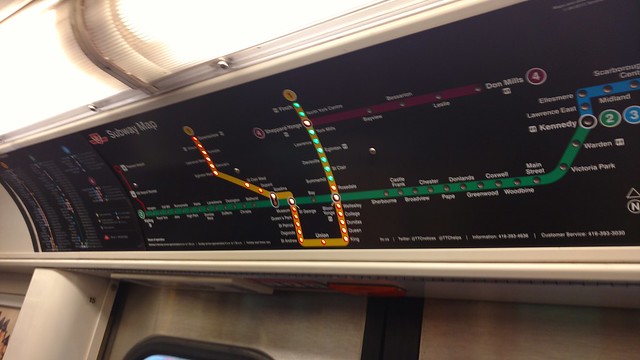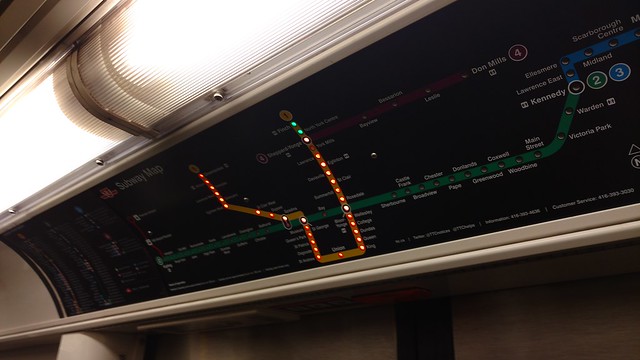reaperexpress
Senior Member
Likes:
Correct me if I'm wrong, but this pdf map seems to also load much more quickly than the old one.
I love the addition of a "Spadina Tunnel: 3 minutes walking" warning. Now if only we could get the trains to stop telling southbound passengers to "Change here for Line 2" at that station...
Dislikes
While consolidating overlapping routes into a single line does massively improve neatness, it does make it a bit harder to figure out where each individual route goes. It's mostly an issue where routes merge and unmerge, like over the Leaside Viaduct. For the typical situation where routes branch off heading away from a subway station, the merged design is fine.
The on-street looping for the 510 short turn along Adelaide, Charlotte and King is not shown. Instead there's just a dot labeled "510C" south of King. The actual looping route is useful information that should not be omitted.
I'm not sure about using GO's proper line colours. This is not a GO map - there are two completely separate fare systems. But the main issue is that Lakeshore East's red makes it look like a TTC route. I'd probably stick with a single colour for all GO lines.
I miss the use of the Toronto Subway typeface for station names. I get that the new font is more legible, but I really like the character of the TTC's own font, as well as the extra differentiation between street names and station names (i.e. DUFFERIN vs Dufferin St)
Overall it's a very impressive redesign.
Correct me if I'm wrong, but this pdf map seems to also load much more quickly than the old one.
I love the addition of a "Spadina Tunnel: 3 minutes walking" warning. Now if only we could get the trains to stop telling southbound passengers to "Change here for Line 2" at that station...
Dislikes
While consolidating overlapping routes into a single line does massively improve neatness, it does make it a bit harder to figure out where each individual route goes. It's mostly an issue where routes merge and unmerge, like over the Leaside Viaduct. For the typical situation where routes branch off heading away from a subway station, the merged design is fine.
The on-street looping for the 510 short turn along Adelaide, Charlotte and King is not shown. Instead there's just a dot labeled "510C" south of King. The actual looping route is useful information that should not be omitted.
I'm not sure about using GO's proper line colours. This is not a GO map - there are two completely separate fare systems. But the main issue is that Lakeshore East's red makes it look like a TTC route. I'd probably stick with a single colour for all GO lines.
I miss the use of the Toronto Subway typeface for station names. I get that the new font is more legible, but I really like the character of the TTC's own font, as well as the extra differentiation between street names and station names (i.e. DUFFERIN vs Dufferin St)
Overall it's a very impressive redesign.
Last edited:






